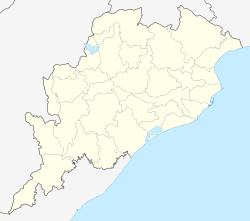Digambara Jaina Temple, Khandagiri
Lua error in package.lua at line 80: module 'strict' not found.
| Digambar Jain Temple, Khandagiri | |
|---|---|
| 270px
Digambar Jain Temple, Khandagiri
|
|
| Basic information | |
| Location | Odisha, India |
| Geographic coordinates | Lua error in package.lua at line 80: module 'strict' not found. |
| Affiliation | Jainism |
| Architectural description | |
| Specifications | |
Digambara Jaina Temple is a Jain temple in Bhubaneswar, in the state of Odisha, India. The temple is on the top of Khandagiri hill. This hill is honeycombed with a series of rock-cut Jaina caves, commissioned by King Kharavela in 1st century BCE. The rock-cut caves are protected by Archaeological Survey of India. The enshrining deities are a series of Jaina tirthankara images.
Contents
Ownership
The temple is maintained by the Bengal, Bihar and Odisha Digambara Jaina Tirthankara Committee. Bimala Devi Jain is the local caretaker.[citation needed]
Age
The architecture of the temple suggest that it was built out of materials from an earlier temple. The new temple was built in the 19th century CE.[citation needed]
Property type
Precinct/ Building/ Structure/Landscape/Site/Tank: precinct
Sub type: Temple
Typology: Pidha Deula
Property use
Abandoned/ in use: In use
Present use: Living Temple
Past use: Worshiped
Significance
Local legends ascribe the temple to Mahameghabahana Kharavela of 1st century BCE. This legend is not supported by the architectural features.
Physical description
The temple, which faces east, is next to the Rushavanath temple in the south at a distance of 3.50 metres, a northern compound wall at a distance of 2.50 metres and western compound wall at a distance of 11.50 metres.
Architectural features (Plan and Elevation): The temple stands on a platform that measures 16.00 metres in length by 9.50 metres in width with a height of 1.62 metres. On plan, the temple has a vimana and a jagamohana. The vimana measures 8.25 square metres and jagamohana measures 6.40 metres in length and 9.40 metres in breadth. This temple is triratha on plan. It is distinguished by central raha and kanika pagas on either sides. On elevation, the vimana is pidha deula that measures 5.80 metres in height from pabhaga to mastaka. The temple has panchanga bada. From bottom to top the temple has a pabhaga, talajangha, bandhana, upara jangha, baranda, gandi and mastaka. The pabhaga measures 0.47 metres, talajangha 0.42 metres, bandhana 0.16 metres, upara jangha 0.40 metres and baranda 0.45 metres. The gandi measures 1.80 meters with seven receding tiers arranged in two sets (potala); lower potala has four tiers and upper potala with three tiers and mastaka measures 2.10 metres.
Raha niche & parsva devatas: There are no parsvadevata niches and the walls are plain and without sculptural embellishments. The northern side wall has a balustraded window and this window is decorated with a series of pidha mundi.
Decorative features: Doorjambs: There are two doorways in north and east. The eastern doorjambs measure 2.88 metres x 1.56 metres, which is carved with khakhara mundi niches at the base. The northern doorjambs measure 2.20 metres x 1.04 metres.
Building material: Sandstone
Construction techniques: Dry masonry
Style: Kalingan
State of preservation
Good/Fair/ Showing Signs of Deterioration/Advanced: Fair
Grade (A/B/C)
Architecture: B
Historic: C
Associational: A
Social/Cultural: B
Threats to the property
Conservation Problem and Remedies:
Compound wall: There is a compound wall covering the precinct.
References
- ↑ Pradhan, Sadasiba (2009). Lesser Known Monuments Of Bhubaneswar. Bhubaneswar: Lark Books. pp. 1–2. ISBN 81-7375-164-1.
- ↑ Lua error in package.lua at line 80: module 'strict' not found.
